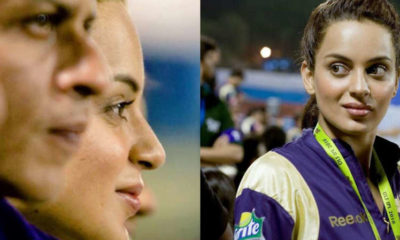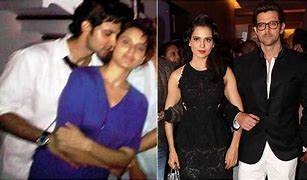Entertainment
‘Tanu Weds Manu Returns’ – watch it for Kangana’s dual magic

Film: “Tanu Weds Manu Returns”; Cast: Kangana Ranaut, R. Madhavan, Jimmy Sheirgill, Deepak Dobriyal, Eijaz Khan, Swara Bhaskar, Mohammad Zeeshan Ayyb, Rajendra Gupta, Navni Parihar, K.K. Raina and Dipti Mishra; Director: Anand L. Rai; Rating: ***
Very rarely do sequels create an impact as the original, but in the case of “Tanu Weds Manu Returns”, the intensity is as forceful or more than the original. Once again packed with sharp and witty dialogues, fine performances and a feel-good factor, “Tanu Weds Manu Returns” excels as a scaled-up family entertainer.
This sequel takes off from where it left in the previous edition in 2011 and returns with the lead pair after four years of jaded bliss. Their marriage is now on the rocks. Tanuja Trivedi aka Tanu is as moody as she was and he, Manoj Sharma aka Manu is at the end of his tether.
Still in London, their divorce is inevitable after Tanu manages to ensure that Manu is kept back in St. Benedict Mental Hospital in Twickenham in Britain. She returns to Kanpur to her family. Manu too returns forlorn to India where he lands up meeting Kusum Sangwan, who is Tanu’s lookalike. Seemingly in love with Kusum, he decides to remarry.
With well-etched but flawed characters, the performance of each actor is noteworthy. Kangana steals the show with the dual role she essays. In both her characters, she is distinct in her sartorial style, speech and mannerisms. As Tanu, she is an extension of herself as portrayed in the earlier edition. But as Kusum Sangwan, a Haryanvi athlete, she brings out a sharp contrast, exhibiting her prowess as an actress. Kusum’s simplicity and sincerity get you emotionally attached to her.
R. Madhavan complements her with his overall subtle and restrained performance. He plays the traumatised husband to the hilt. But he also hits the right high-pitched notes convincingly as the harassed husband at the mental hospital.
Of the rest of the supporting cast, Mohammed Zeeshan Ayyub as advocate Arun Kumar Singh is vibrant. With his casual, yet evocative performance, he displays sparks of brilliance. Deepak Dobriyal as Pappi, Manu’s confidante is over-the-top. He is repetitive and after a while, is jarring in the narration.
Jimmy Sheirgill as Raja Awasthi has a few scenes where he makes his presence felt as the unlucky man-in-love. Swara Bhaskar as Payal along with Eijaz Khan as Jassi, make a fine pair and are fairly noticeable.
Director Anand L.Rai’s plot is punctuated with moments of family tension and spiced with great rustic colloquial one-liners that sparkle. The dialogues keep you in splits.
His screenplay is frothy and he takes a lazy approach in certain scenes. Though scene after scene you roll with laughter, they falter at times with forced humour. This is evident in the seminar scene, where Manu is invited to give a medical speech.
The graph of the narration too, is inconsistent. The first half though flighty, is engaging. The second half digresses with lengthy unwarranted scenes; especially the scene which has Geeta Dutt’s song “Ja, ja, ja bewafa” as the background score and Tanu wandering aimlessly on the streets.
The rest of the songs merge well into the narration. The English jazz number, “So What if I am an old school girl” takes you by surprise. It stands out as an odd piece, but one that settles well into the overlay. It is well-picturised too. The background score is loud and excessive, but suits the overall design of the film.
Conceived as a realistic film, the production quality is apt and cinematographer Chirantan Das’s frames are atmospheric. They capture the small town ambience perfectly.
Kangana’s performance unarguably ups the viewing quotient of the film. So watch this film for her and Himanshu Sharma’s razor-sharp dialogues.
Entertainment
Casino Days Reveal Internal Data on Most Popular Smartphones

International online casino Casino Days has published a report sharing their internal data on what types and brands of devices are used to play on the platform by users from the South Asian region.
Such aggregate data analyses allow the operator to optimise their website for the brands and models of devices people are actually using.
The insights gained through the research also help Casino Days tailor their services based on the better understanding of their clients and their needs.
Desktops and Tablets Lose the Battle vs Mobile
The primary data samples analysed by Casino Days reveal that mobile connections dominate the market in South Asia and are responsible for a whopping 96.6% of gaming sessions, while computers and tablets have negligible shares of 2.9% and 0.5% respectively.
The authors of the study point out that historically, playing online casino was exclusively done on computers, and attribute thе major shift to mobile that has unfolded over time to the wide spread of cheaper smartphones and mobile data plans in South Asia.
“Some of the reasons behind this massive difference in device type are affordability, technical advantages, as well as cheaper and more obtainable internet plans for mobiles than those for computers,” the researchers comment.
Xiaomi and Vivo Outperform Samsung, Apple Way Down in Rankings
Chinese brands Xiaomi and Vivo were used by 21.9% and 20.79% of Casino Days players from South Asia respectively, and together with the positioned in third place with a 18.1% share South Korean brand Samsung dominate the market among real money gamers in the region.
Cupertino, California-based Apple is way down in seventh with a user share of just 2.29%, overshadowed by Chinese brands Realme (11.43%), OPPO (11.23%), and OnePlus (4.07%).
Huawei is at the very bottom of the chart with a tiny share just below the single percent mark, trailing behind mobile devices by Motorola, Google, and Infinix.
The data on actual phone usage provided by Casino Days, even though limited to the gaming parts of the population of South Asia, paints a different picture from global statistics on smartphone shipments by vendors.
Apple and Samsung have been sharing the worldwide lead for over a decade, while current regional leader Xiaomi secured their third position globally just a couple of years ago.
Striking Android Dominance among South Asian Real Money Gaming Communities
The shifted market share patterns of the world’s top smartphone brands in South Asia observed by the Casino Days research paper reveal a striking dominance of Android devices at the expense of iOS-powered phones.
On the global level, Android enjoys a comfortable lead with a sizable 68.79% share which grows to nearly 79% when we look at the whole continent of Asia. The data on South Asian real money gaming communities suggests that Android’s dominance grows even higher and is north of the 90% mark.
Among the major factors behind these figures, the authors of the study point to the relative affordability of and greater availability of Android devices in the region, especially when manufactured locally in countries like India and Vietnam.
“And, with influencers and tech reviews putting emphasis on Android devices, the choice of mobile phone brand and OS becomes easy; Android has a much wider range of products and caters to the Asian online casino market in ways that Apple can’t due to technical limitations,” the researchers add.
The far better integration achieved by Google Pay compared to its counterpart Apple Pay has also played a crucial role in shaping the existing smartphone market trends.
Content provided by Adverloom

























